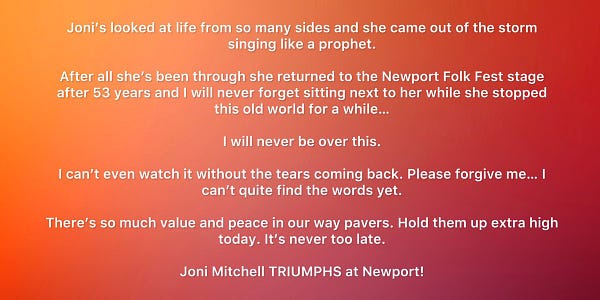And Now For Something Completely Different
In which the author tries to bring his readers to tears
Today’s challenge to my gentle reader is to watch the 5:32 of the above video without wiping away a tear or two. I owe a big “thank you” to Mary Trump, on whose Substack newsletter I found it. “Emergency art” is how she referred to it, and it’s indeed five-and-a-half minutes of beauty in a world that can sometimes seem rather dark.
That Joni Mitchell can sing at all is something of a miracle. After suffering a debilitating brain aneurysm in 2015, most people believed she’d never perform again. Yet, there she was at the Newport Jazz Festival this past Sunday, where she performed a full set.
"The last time Joni performed with guitar in hand in front of a paying audience was 8,660 days ago, on her 55th birthday," according to Mitchell's website.
Many devoted fans never thought this day would come again after Mitchell's brain aneurysm – an abnormal swelling in an artery in the brain – which left her unable to speak or walk, much less play the guitar.
In an interview with CBS News after her performance, she discussed losing the ability to do basic things like walking, talking, and even getting out of a chair. She described the experience as “a return to infancy.”
She’s relearned how to communicate- how to speak and how to sing. She taught herself how to play the guitar again by watching videos of herself “to see where I put my fingers.”
So after suffering a debilitating brain aneurysm seven years ago and having to relearn many fundamental skills and then re-teaching herself how to play the guitar, she was able to perform a set at Newport- including a three-minute guitar solo. And she was terrific.
On the one hand, the video shows Joni Mitchell playing guitar, which for a woman closing in on 80, is impressive enough.
But when a doctor puts her aneurysm into perspective, it makes what she did in Newport even more awe-inspiring:
Dr. Anthony Wang, a neurosurgeon at Ronald Reagan UCLA Hospital, is among those who are astounded by Mitchell's recovery.
"To be able to recover to the point of being able to perform as a musician is really incredible," Wang told NPR. Brain surgeons often use "return-to-work" as a marker of a successful functional recovery, he explained. "But very rarely is that work quite so nuanced."
While there are different types of aneurysm events, Wang explained that the most life-threatening are those in which the weakened wall of the blood vessel balloons out, then ruptures because of the intense pressure.
"That's a really dangerous condition and nearly half of those patients die before they ever make it to the hospital," Wang said "And the ones who do, about half of them are left with permanent neurologic problems."
For those who do survive a rupture, Wang said "that event will cause problems like paralysis or coma, aphasia and seizures."
Mitchell was found unconscious in her home on March 31, 2015, and she’s never openly discussed the details of her aneurysm. What seems beyond doubt is the amount of determination and hard work it took for Mitchell to regain even a fraction of her skills. To be able to get to the point where she’s capable of performing again is difficult to imagine.
A few years ago, I watched a documentary on Glen Campbell’s journey with Alzheimer’s Disease. His disease was notable because, even in the worst of times, when he couldn’t remember his wife or anyone close to him, he never forgot how to play the guitar.
No matter how bad things were, he could pick up his guitar, and it was as if everything was normal. The chords, the fingering, the picking- all of it came back to him as if it had never left- and it hadn’t. It was amazing to watch. He couldn’t remember anything else, but with a guitar in his hands, he was the same Glen Campbell he’d always been.
Joni Mitchell’s journey has been a fair bit different, of course. First, she had to relearn how to speak and sing. Then, she re-taught herself how to play the guitar by watching old videos of herself. However, she’d never lost her musical talent, and her three-minute electric guitar solo is evidence of that. What you see during her solo is the product of aging. Joni Mitchell is a 78-year-old woman who’s had a rough go over the past few years. That she was able to perform a full set a Newport, including standing up to perform a three-minute electric guitar solo, borders on miraculous. But the talent is unmistakable.
What I found even more touching was the boundless love and reverence the assembled performers on the stage have for her. You could see it in their faces. They know the challenges and difficulties in what they do, and they’re aware of what Joni Mitchell has been through over the past seven years. They, more than anyone, understand what she’s had to relearn to get back to where she is now.
Mitchell has been the musical community’s eminence grise for decades. Her struggles over the past few years have only cemented the love so many performers feel for her.
I’ve never been a huge Joni Mitchell fan, but that’s a matter of personal preference. There’s no disputing the impact she’s had on modern music. There’s no doubt about her singular talent as a singer/songwriter. And her influence on younger performers is immeasurable.
The video of her performing “Both Sides Now” is incredibly moving. It’s not Joni Mitchell trying to recapture her youth. Instead, she’s fully inhabiting and embracing where she is in life. The voice isn’t as smooth or carefree as it once was, but that’s part of what made the moment so emotional. It was Joni Mitchell as she is, and it was beautiful, especially considering what she’s overcome.
If that doesn’t have you reaching for a box of Kleenex, I don’t know what will.







